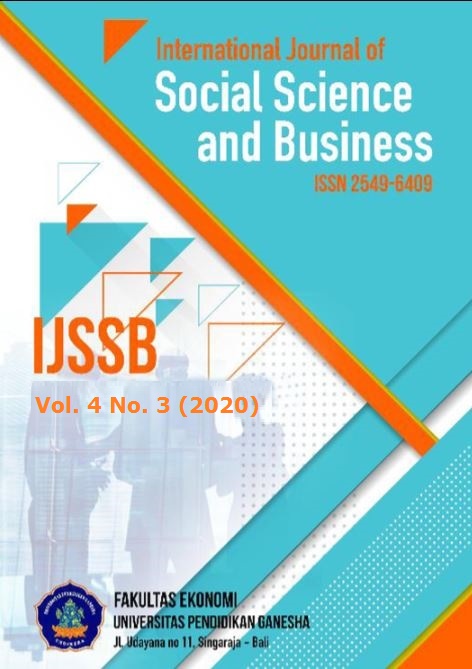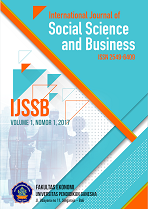Internal Control Capabilities with Menyama Braya Concept as An Effort To Saving Bad Loans in Bumdes
DOI:
https://doi.org/10.23887/ijssb.v4i3.28288Keywords:
Internal Control System, Menyama Braya Culture, Bad loans SavingAbstract
Bad credit must still be saved to reduce the amount of losses and keep BUMDes afloat. The purpose of this research is to analyze the internal control capabilities with local wisdom of menyama braya as a bad loans saving effort. The research population is all bumdes active in Buleleng Regency. The sampling in this study used random sampling techniques so that 92 observational data were obtained. The data analysis technique used in this study is sem component based analysis method, Partial Least Square (PLS). Based on the results of the coefficient path, the influence of the internal control system on the bad credit saving strategy is significant which is shown with a value of T statistics of “1.96” which is 2,890 or p-values is significant < 0.05. Cultural Moderation between the relationship of the internal control system to the bad credit saving strategy shows a static T value of 2,637 greater than 1.96 with a p-values value of <0.05). The results showed that internal control systems had a positive effect on bad loans saving strategies. And the culture of menyama braya moderates the relationship between internal control systems and bad credit saving strategies. BUMDes who are obedient in their internal control system, then based on acting using the concept of menyama braya culture, turned out to be an effective force in the efforts to save bad loans that occurred.
References
Atmadja, A. T., Darmawan, N. A. S., Saputra, K. A., & Kurniawan. (2015). Pengaruh Implementasi Good Corporate Governance Dan Proteksi Awig-Awig Terhadap Kinerja Lembaga Perkreditan Desa (LPD) Dengan Budaya Menyama Braya Sebagai Variabel pemoderasi (Studi Pada LPD Se-Kabupaten Buleleng). 1, 1–24.
Chosyali, A., & Sartono, T. (2019). Optimalisasi Peningkatan Kualitas Kredit Dalam Rangka Mengatasi Kredit Bermasalah. Law Reform, 15(1), 98. https://doi.org/10.14710/lr.v15i1.23357
Idawati, W., & Eleonora, L. (2020). Penerapan Sistem Pengendalian Intern dan Akuntabilitas Keuangan dalam Mewujudkan Kualitas Laporan Keuangan. Equity, 22(2), 153. https://doi.org/10.34209/equ.v22i2.1367
Jumaiyah, J., & Mawardiani, A. F. (2017). Studi hermeneutika pengendalian intern pemberian kredit badan usaha milik desa (BUMDes). Jurnal Aplikasi Bisnis, 17(2), 75–92. https://doi.org/10.20885/jabis.vol17.iss2.art5
Kalendesang, A. K., Lambey, L., & Budiarso, N. S. (2017). Analisis Efektivitas Sistem Pengendalian Internal Persediaan Barang Dagang Pada Supermarket Paragon Mart Tahuna. Going Concern : Jurnal Riset Akuntansi, 12(2), 131–139. https://doi.org/10.32400/gc.12.2.17443.2017
Kementerian, D. (2020). Revitalisasi BUMDes. 2–4.
Kusumawati, N., & Jimmi. (2015). Pengaruh Pengendalian Internal Terhadap Tingkat Kredit Macet Dalam Proses Pembiayaan Sepeda Motor PT. Radana Finance Cabang Tangerang Kota, Banten. Jurnal Akuntansi & Keuangan, Vol. 2 No 1, 2(1), 1689–1699.
Lestari, R. M. E., & Masruroh, M. (2015). Peran Sistem Pengendalian Internal Pemberian Kredit Dalam Meminimalisasi Non Performing Loan Pada Pt Bank Mitraniaga, Tbk. JIAFE (Jurnal Ilmiah Akuntansi Fakultas Ekonomi), 1(2), 1–11. https://doi.org/10.34204/jiafe.v1i2.511
Ludji, F., Samiyono, D., & Lattu, I. Y. M. (2020). " Menyama Braya ": The Main Foundation of Religion-Religion Dialogue in Dalung Village , Bali. 5(2), 82–95.
Monteiro, I. G. A. P., Julianto, I. P., & Prayudi, M. A. (2017). Kredit Bermasalah Pada Koperasi Serba Usaha Merta Asih Di Kecamatan Jembrana , Kabupaten Jembrana Jurusan Akuntansi Program S1 e-Journal S1 Ak Universitas Pendidikan Ganesha. 1(2).
Rotti, M. R., Manossoh, H., & Kalalo, M. Y. B. (2017). Evaluasi Pengendalian Internal Terhadap Kredit Diragukan Pada Pt. Bank Sulutgo Di Minahasa Induk. Going Concern : Jurnal Riset Akuntansi, 12(2), 818–827. https://doi.org/10.32400/gc.12.2.18245.2017
Savitri, M. R. M. E., Musmini, I. L. S., & Julianto, I. I. P. (2018). PENERAPAN KONSEP MENYAMA BRAYA DALAM MEWUJUDKAN. 128–138.
Sri Ayuni, N. M., & Novi Budiasni, N. W. (2019). The Strategy of Bad Loans “Pang Pade Payu” in Village Credit Institution in Buleleng District. International Journal of Social Science and Business, 3(4), 542. https://doi.org/10.23887/ijssb.v3i4.21887
Ulfa. (2018). Pengaruh Faktor Internal Debitur Terhadap Kredit Bermasalah pada PT. Bank Negara Indonesia (Persero) Tbk Cabang Palu. Katalogis, 5(9), 45–54.
Widarta, I. K. D. G. S., Atmadja, A. T., & Wahyuni, M. A. (2017). Memaknai kearifan lokal menyama braya sebagai landasan sistem pengendalian manajemen pada starlight restaurant bungalows. JIMAT (Jurnal Ilmiah Mahasiswa Akuntansi) Undiksha, 7(1). https://doi.org/10.23887/JIMAT.V7I1.9493
Wiradana, I. G. O., Sulindawati, N. L. G. E., & Admadja, A. T. (2015). Analisis Penerapan Sistem Pengendalian Internal Terhadap Pemberian Kredit Di Lembaga Perkreditan Desa (Studi Empiris Lembaga Perkreditan Desa Poh Bergong). JIMAT (Jurnal Ilmiah Mahasiswa Akuntansi S1), 3(1). https://doi.org/10.23887/jimat.v3i1.4697











